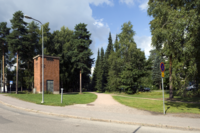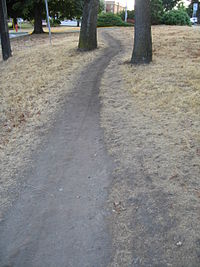- Desire path
-
A desire path (also known as a desire line or social trail) is a path developed by erosion caused by footfall. The path usually represents the shortest or most easily navigated route between an origin and destination. The width and amount of erosion of the line represents the amount of demand.
Desire paths can usually be found as shortcuts where constructed pathways take a circuitous route.
They are manifested on the surface of the earth in certain cases, e.g., as dirt pathways created by people walking through a field, when the original movement by individuals helps clear a path, thereby encouraging more travel. Explorers may tread a path through foliage or grass, leaving a trail "of least resistance" for followers.
The lines may be seen along an unpaved road shoulder or some other unpaved natural surface. The paths take on an organically grown appearance by being unbiased toward existing constructed routes. These are almost always the most direct and the shortest routes between two points, and may later be surfaced. Many streets in older cities began as desire paths,[citation needed] which evolved over the decades or centuries into the modern streets of today.
Contents
Examples
 A desire path (right) merges with a footpath (center) in Helsinki, Finland
A desire path (right) merges with a footpath (center) in Helsinki, Finland
In Finland, planners are known[citation needed] to visit their parks immediately after the first snowfall, when the existing paths are not visible.[citation needed] People naturally choose desire lines, which are then clearly indicated by their footprints and can be used to guide the routing of paths. Social trails often cut through sensitive habitats and off-limit areas, threatening wildlife and park security. However, social trails also provide to park management an indicator of activity concentration. The National Park Service unit at the Yosemite National Park uses this indicator to help establish its General Management Plan.[citation needed]
The path of Interstate 95 between the cities of Boston and Providence in the USA is said to have originated as a desire line in the form of a trail followed by 17th century Native Americans, which subsequently became a primitive turnpike and eventually a superhighway.[citation needed]
In daily life
More casual trails can be found in parking lots and lawns. Sometimes, vegetation barriers are planted along the pavement to deter off-trail traffic. However, many social trails still penetrate these barriers.
See also
Notes
References
- Throgmorton, James and Eckstein, Barbara Desire Lines: The Chicago Area Transportation Study and the Paradox of Self in Post-War America
- WGBH: A Cape Cod Notebook - Desire Lines by Robert Finch
- Carl Myhill, "Commercial Success by Looking for Desire Lines", in Masoodian, M, Jones, S, Rogers B, (Eds.) 6th Asia Pacific Computer-Human Interaction Conference (APCHI 2004), (Rotorua, New Zealand, June/July 2004). Springer-Verlag
- Lubell, Mark. Lecture9: National Park for ESP172, University of California, Davis
External links
Categories:- Footpaths
- Trails
- Pedestrian infrastructure
- Landscape architecture
- Garden features
- Parks
- Types of thoroughfares
- Transportation planning
- Psychogeography
- Cultural geography
- Human geography
Wikimedia Foundation. 2010.

